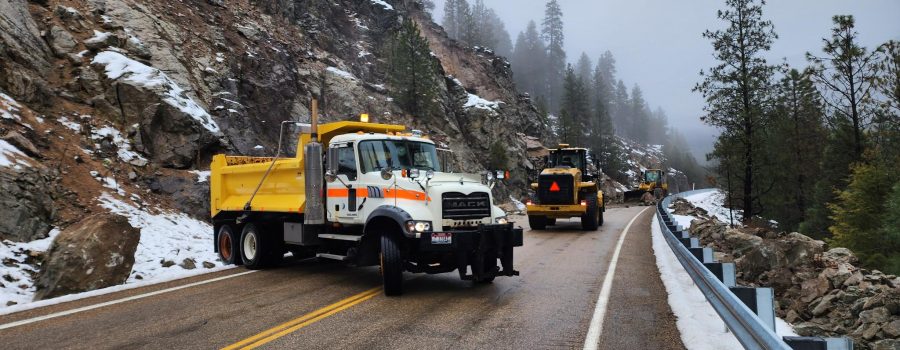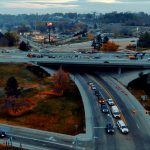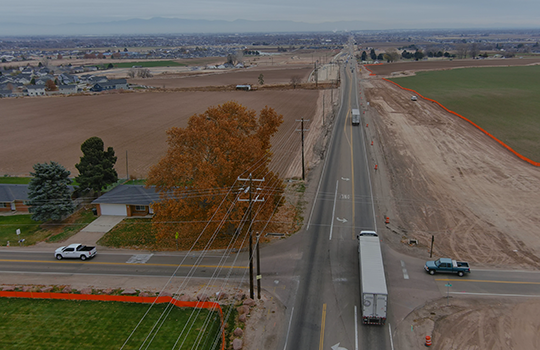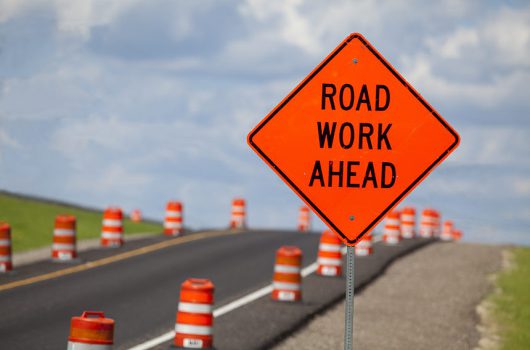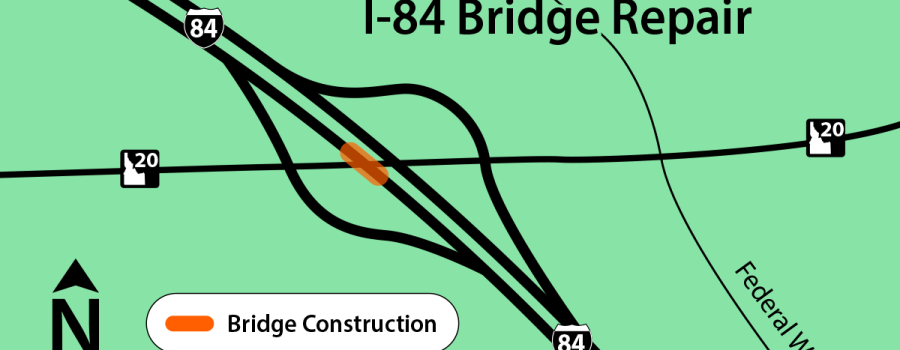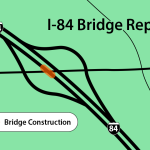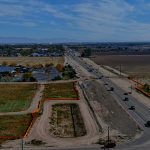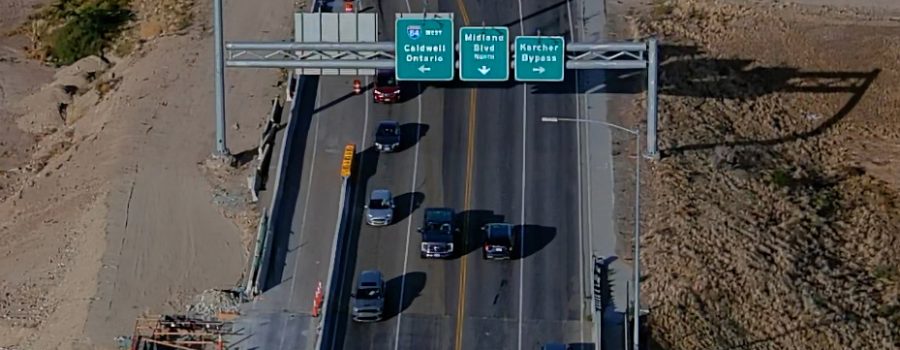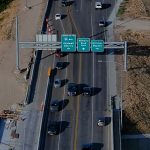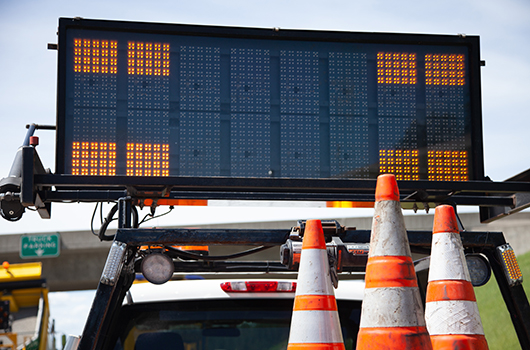A major rockslide happened overnight on State Highway 21 which has closed the highway between Sourdough and Banner Summit.
Crews are at the site of the slide assessing conditions and damage and preparing a plan for cleanup.
At this time the expected duration of the closure is not known. Drivers should use Idaho 511 as the best source information regarding closures and detour routes.
Additional information will be released once it is available.
The Idaho Transportation Department will shift eastbound Interstate 84 traffic and begin intermittent closures of 10th Avenue in Caldwell on Monday, Dec. 15 as crews demolish the final side of the 10th Avenue bridge.
On Sunday, Dec. 14, eastbound I-84 traffic will shift onto the newly paved lanes in the center of I-84 between the 10th Avenue and Franklin Road interchanges. This traffic shift will allow crews to safely demolish the eastbound side of the bridge.
Watch the video to see the new eastbound traffic configuration. Click here to watch the video.
WHAT TO EXPECT ON I-84:
- Starting Tuesday, Dec. 9, there will be overnight single-lane closures from 10 p.m. to 5 a.m. on eastbound and westbound I-84 so crews can stripe, set barriers and prepare to shift traffic.
- On Sunday, Dec. 14, eastbound I-84 traffic will shift onto the newly paved lanes in the center of I-84 between the Centennial Way and Franklin Road interchanges.
- The Franklin Road eastbound off-ramp and the 10th Avenue eastbound on- and off-ramps will close overnight Sunday, Dec. 14, from 10 p.m. to 5 a.m.
- Eastbound drivers heading into Caldwell must exit I-84 at Centennial Way (Exit 27). Drivers who miss the exit, will travel to the Karcher Interchange in Nampa to turn around. Click here to view a detour map.
- I-84 will remain open, but drivers should plan for delays and allow extra time to travel through the area.
WHAT TO EXPECT ON 10TH AVENUE:
- Starting Monday, Dec. 15, 10th Avenue will close intermittently under I-84 between the eastbound and westbound ramps. 10th Avenue will reopen prior to Christmas.
- During closures, traffic will be detoured to Centennial Way. Click here to see a detour map.
- Access to businesses will remain open, but routes may change during closures.
- Shuttle buses will be available for pedestrians and bicyclists, with bus stops on either end of the closure. Click here to view a map of bus stop locations.
Crews demolished the westbound side of the bridge in 2024 and are now completing the final phase by demolishing the eastbound side. This work will take a couple weeks to complete.
This work is part of ITD’s I-84 Centennial Way to Franklin Road project, which will widen I-84, replace the 10th Avenue Interchange, improve walking and biking connections and add other improvements in Caldwell. The project is expected to be complete in 2027.
For more information about the project and to stay updated on closure dates:
All work is weather dependent and the schedule may change. To plan your route in advance, visit 511.idaho.gov.
The Idaho Transportation Department will shift traffic at the State Highway 16 and State Highway 44 intersection overnight, starting tomorrow evening.
Drivers can expect nighttime flagging and reduced speeds from 9 p.m. to 5 a.m. as crews move traffic into a new configuration. The shift will allow two lanes of traffic in each direction along SH-44 while crews continue constructing the north-side interchange ramps.
Beginning Thursday a new traffic pattern will be in place at the intersection. In response to community feedback, ITD rephased construction to reopen two lanes in each direction on SH-44 during the next stage of work. This change is expected to reduce congestion and improve traffic flow during peak travel times.
During this phase, motorists can expect:
- SH-44 reopened to two lanes in each direction between SH-16 and Short Road.
- Two left-turn lanes reopened from SH-16 to eastbound SH-44.
- SH-16 to remain one lane in each direction south of SH-44.
“We have been challenged with finding ways to improve traffic flow in this corridor, and this traffic shift is a significant step forward,” ITD Design and Construction Engineer Styles Salek said. “Reopening two lanes on SH-44 should reduce delays and improve travel through the work zone.”
The SH-16, SH-44 interchange is part of ITD’s long-term plan to develop SH-16 as a limited-access freeway between Interstate 84 and SH-44. When complete, drivers will access the corridor through interchanges at I-84, Franklin Road, Ustick Road, U.S. Highways 20 and 26 and SH-44.
Drivers can sign up for text or email updates by texting HIGHWAY16to 866-483-8422. Project information and maps are available at itdprojects.idaho.gov/pages/sh16corridor.
All work is weather-dependent and subject to change. For the most up to date travel information, drivers should check 511.idaho.gov.
The Idaho Transportation Department will close State Highway 55 (Karcher Road) between Montana Avenue and Indiana Avenue this weekend. The closure will begin Friday at 10 p.m. with the highway reopening Monday at 5 a.m. This closure will allow crews to replace irrigation infrastructure just west of the SH-55 and Indiana Avenue intersection. This work is necessary before crews widen this portion of the roadway. The widening of SH-55 from Farmway Road to Middleton Road is anticipated to be complete by 2027.
Motorists are encouraged to use Interstate 84, State Highway 19 and U.S. 95 as a detour. To view a map of the closure location and detour, click here.
To receive text alerts about these weekend closures, text 55FARMWAY to 866-483-8422.
All work is weather-dependent and subject to change. For the most up to date travel information, drivers should check 511.idaho.govbefore traveling.
This work is a part of the larger SH-55, Farmway Road to Middleton Road project which will improve safety and mobility along the SH-55 Corridor in Canyon County. Construction is expected to finish in fall of 2027. For more information about the SH-55: Farmway to Middleton widening project, please visit itdprojects.idaho.gov/pages/55farmway, call 208-477-1379, or email info@55farmwaytomiddleton.org.
The Idaho Transportation Department will begin utility potholing work next Monday as part of the Elijah Drain culvert repair project beneath State Highway 45 (12th Avenue). Potholing is the process of digging small, targeted holes to safely locate underground utilities before construction begins.
Crews will pothole to locate underground utilities ahead of construction planned for later this month. This work is necessary to avoid conflicts with utilities during full construction and to reduce the risk of unexpected delays later in the project.
Drivers can expect intermittent lane closures on SH-45 while crews complete the work. Access to nearby businesses, including parking and drive-thru operations, will remain open.
Construction on the full culvert repair is expected to be complete by April 2026.
Motorists should plan ahead and check 511.idaho.gov for traffic impacts and updates.
The Idaho Transportation Department will close a single lane on Interstate 84 eastbound at the Gowen Road exit from 8 a.m. to 5 p.m. Tuesday to complete bridge repair work, weather permitting.
Work is required to be done during the day due to temperature requirements to effectively apply repair materials. A single lane will remain open, with traffic alternating between lanes as needed throughout the work period.
Work on the bridge was completed overnight earlier this summer. This daytime closure will allow ITD crews to finish the remaining repairs and restore the structure to full service.
Drivers should expect delays and are encouraged to plan ahead. For the most current traffic updates, visit 511.idaho.gov or download the ITD 511 app.
Starting Monday, the Idaho Transportation Department will be working along Eagle Road between Chinden Boulevard and Ustick Road to work on underground utilities for the installation of variable speed limit signs.
Motorists can expect lane closures from 10 p.m. to 6 a.m. until Dec. 10. Pedestrian traffic will be detoured to alternate routes along Eagle Road, Chinden Boulevard, and McMillian Road for daytime sidewalk and shoulder closures.
This work is part of the on-going effort to improve safety on Eagle Road. These variable speed limit signs will provide speed feedback for drivers and reduce speed limits during peak traffic times. The signs are expected to be operational within the next few months.
For more details about the VSL sign project, visit: https://itdprojects.idaho.gov/pages/eagle-road-safety-corridor
The Idaho Transportation Department will close State Highway 55 (Karcher Road) between Florida Avenue and Lake Avenue from Friday at 10 p.m. until Monday at 5 a.m.
This will allow crews to replace an irrigation pipe just east of the SH-55 and Florida Avenue intersection, which must be completed before paving the roadway.
Highway traffic is encouraged to detour around the closure using Interstate 84, State Highway 19 and U.S. 95. To view a map of the closure location and detour visit the project website at itdprojects.idaho.gov/pages/55farmway
This work is a part of the larger SH-55 project occurring between Farmway Road and Middleton Road to improve safety and mobility along the SH-55 Corridor in Canyon County. Construction is expected to be finished in fall 2027.
For more information about the SH-55 Farmway to Middleton widening project, please visit itdprojects.idaho.gov/pages/55farmway, call 208-477-1379, or email info@55farmwaytomiddleton.org.
To receive text alerts about these weekend closures, text 55FARMWAY to 866-483-8422.
The Idaho Transportation Department will close the Karcher Overpass Bridge on Monday, and Tuesday from 10 p.m. to 5 a.m each night. Crews will be removing the large steel structure that holds the signs over the bridge to make room for new signs that will support the new lane configuration.
Detours signs will be posted for drivers during the closures.
Motorists traveling south on Karcher Road (State Highway 55):
- Travel south on the Karcher Bypass.
- Turn right onto West Karcher Road.
- Turn left onto Midland Boulevard.
- Turn right onto Caldwell Boulevard.
- Continue straight to Karcher Road (SH-55).
Motorists traveling north on Karcher Road (SH-55):
- Use the eastbound on-ramp to merge on to Interstate-84.
- Exit I-84 at Northside Boulevard (Exit 35).
- Travel north on Northside Boulevard.
- Turn left onto Karcher Road/Karcher Bypass.
- Continue on Karcher Road/Karcher Bypass.
Click here to view the detour map.
The I-84, Karcher Interchange project will improve safety and mobility at the interchange and along Karcher Road in Nampa. Crews are expected to place final touches in late spring of 2026.
Stay informed by signing up for email and text alerts regarding project updates by texting 84CORRIDOR to 1-866-483-8422 or visit the project page at itdprojects.idaho.gov/pages/karcheric.
Starting Monday the Idaho Transportation Department will begin a two-week project to micro mill and re-paint the Flying Wye connector linking Interstate 84 and Interstate 184.
This work will take place in two phases:
Phase 1: Nighttime micro milling
Between 10 p.m. and 5 a.m. crews will remove the top layer of pavement overnight to reduce impact on daytime traffic. Drivers should expect lane reductions each night during this phase.
Phase 2: Daytime striping
Striping will then occur during the day when warmer temperatures are required for the paint to adhere to the roadway properly. Lane closures will continue as crews install new markings across the bridge.
Motorists are encouraged to plan for additional travel time and check 511.idaho.gov or the Idaho 511 mobile app for the most current traffic impacts, lane closures and travel conditions throughout the project.
